Related Research Articles
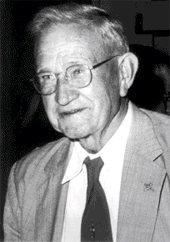
Edward Elmer Smith was an American food engineer and science-fiction author, best known for the Lensman and Skylark series. He is sometimes called the father of space opera.

The Lensman series is a series of science fiction novels by American author E. E. "Doc" Smith. It was a runner-up for the 1966 Hugo Award for Best All-Time Series, losing to the Foundation series by Isaac Asimov.

The space marine is an archetype of military science fiction describing a kind of soldier who operates in outer space or on alien worlds.

The Skylark of Space is a science fiction novel by American writer Edward E. "Doc" Smith, written between 1915 and 1921 while Smith was working on his doctorate. Though the original idea for the novel was Smith's, he co-wrote the first part of the novel with Lee Hawkins Garby, the wife of his college classmate and later neighbor Carl Garby. The novel starts as an edisonade, but turns into a space travel adventure when the characters go into deep space. The Skylark of Space is considered to be one of the earliest novels of interstellar travel and the first example of space opera. Originally serialized in 1928 in the magazine Amazing Stories, it was first published in book form in 1946 by the Buffalo Book Co. The novel was followed by three sequels, beginning with Skylark Three.
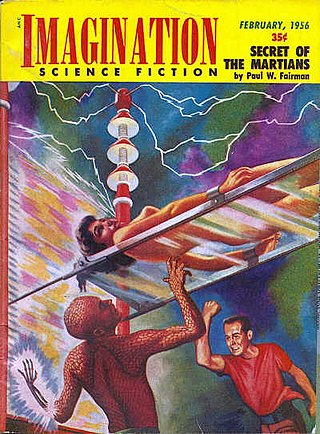
A science fiction magazine is a publication that offers primarily science fiction, either in a hard-copy periodical format or on the Internet. Science fiction magazines traditionally featured speculative fiction in short story, novelette, novella or novel form, a format that continues into the present day. Many also contain editorials, book reviews or articles, and some also include stories in the fantasy and horror genres.
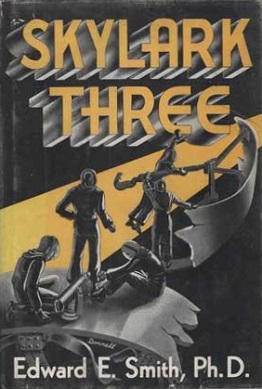
Skylark Three is a science fiction novel by American writer E. E. Smith, the second in his Skylark series. Originally serialized through the Amazing Stories magazine in 1930, it was first collected in book form in 1948 by Fantasy Press.
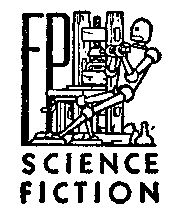
Fantasy Press was an American publishing house specialising in fantasy and science fiction titles. Established in 1946 by Lloyd Arthur Eshbach in Reading, Pennsylvania, it was most notable for publishing the works of authors such as Robert A. Heinlein and E. E. Smith. One of its more notable offerings was the Lensman series.
Gordon Eklund is an American science fiction author whose works include the "Lord Tedric" series and two of the earliest original novels based on the 1960s Star Trek TV series. He has written under the pen name Wendell Stewart, and in one instance under the name of the late E. E. "Doc" Smith.
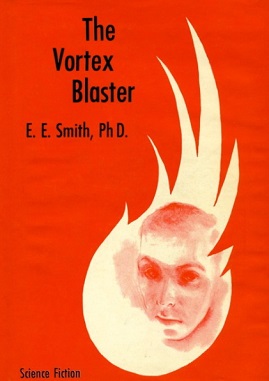
The Vortex Blaster is a collection of three science fiction short stories by American writer Edward E. Smith. It was simultaneously published in 1960 by Gnome Press in an edition of 3,000 copies and by Fantasy Press in an edition of 341 copies. The book was originally intended to be published by Fantasy Press, but was handed over to Gnome Press when Fantasy Press folded. Lloyd Eshbach, of Fantasy Press, who was responsible for the printing of both editions, printed the extra copies for his longtime customers. The stories originally appeared in the magazines Comet and Astonishing Stories.
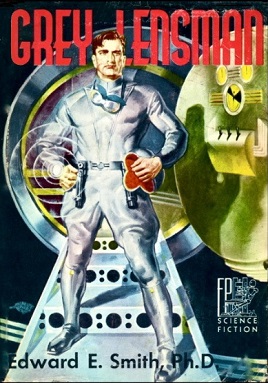
Grey Lensman is a science fiction novel by American writer E. E. Smith. It was first published in book form in 1951 by Fantasy Press in an edition of 5,096 copies. The novel was originally serialized in the magazine Astounding in 1939. Grey Lensman is the fourth book in the Lensman series and the second to focus on the adventures of Lensman Kimball Kinnison.

Triplanetary is a science fiction novel and space opera by American writer E. E. Smith. It was first serialized in the magazine Amazing Stories in 1934. After the original four novels of the Lensman series were published, Smith expanded and reworked Triplanetary into the first of two prequels for the series. The fix-up novel Triplanetary was published in book form in 1948 by Fantasy Press. The second prequel, First Lensman, was a new original novel published in 1950 by Fantasy Press.

Skylark of Valeron is a science fiction novel by the American writer E. E. Smith, the third in his Skylark series. Originally serialized in the magazine Astounding in 1934, it was first collected in book form in 1949 by Fantasy Press.

First Lensman is a space opera novel by American author E. E. Smith. It was first published in 1950 by Fantasy Press in an edition of 5995 copies. It is, in terms of internal chronology, the second novel in the Lensman series, but the sixth written by Smith.

Galactic Patrol is a science fiction novel by American author E. E. Smith. The novel was originally serialized in the magazine Astounding in 1937. The stories in this volume were the first parts written of the original Lensman saga. It was later published in book form in 1950 by Fantasy Press.

Subspace Explorers is a science fiction novel by American writer E. E. "Doc" Smith. It was first published in 1965 by Canaveral Press in an edition of 1,460 copies. The novel is an expansion of Smith's story "Subspace Survivors" which first appeared in the July 1960 issue of the magazine Astounding.
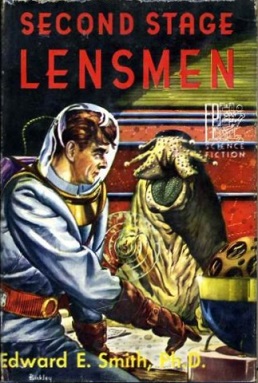
Second Stage Lensmen is a science fiction novel by author Edward E. Smith. It was first published in book form in 1953 by Fantasy Press in an edition of 4,934 copies. The novel was originally serialized in the magazine Astounding beginning in 1941. Second Stage Lensmen is the fifth volume in the Lensman series, and the last to feature Kimball Kinnison as the most powerful Lensman in the service of the Galactic Patrol. Second Stage Lensmen also features the first female Lensman, Clarissa MacDougall. The story mainly focuses upon the exploits of the "Second Stage" Lensmen: those who have gone through the advanced Arisian training Kinnison underwent in Galactic Patrol. These four superior Lensmen, Kinnison, Worsel, Tregonsee, and Nadreck, are armed with mental powers allowing them to control the minds of others and see, hear, and feel without using their physical senses. This elite cadre allows Civilization to tip the balance against Boskone as Second Stage Lensmen abilities are ideally suited to spying and information gathering.

Children of the Lens is a science fiction novel by American author E. E. Smith. It was originally serialized in the magazine Astounding beginning in 1947, and was first published in book form in 1954 by Fantasy Press in an edition of 4,874 copies. It is the last book in Smith's Lensman series.

The History of Civilization is a boxed set of science fiction novels by author Edward E. Smith, Ph.D. It contains the six novels of Smith's Lensman series. The set was published in 1961 by Fantasy Press in an edition of 75 copies. Each volume was printed from the original Fantasy Press plates, but with a new title page giving the name of the set. They were bound in red half-leather, numbered and signed by Smith.

The Mightiest Machine is a science fiction novel by American writer John W. Campbell, Jr. The novel was originally serialized in 5 parts in Astounding Stories magazine from December 1934 to April 1935, and was published in book form in 1947 by The Hadley Publishing Co. in an edition of 1,200 copies. Campbell was a leading figure in the Golden Age of Science Fiction.
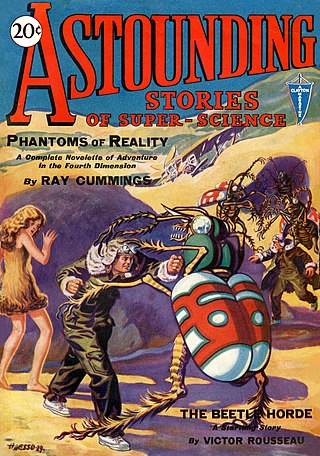
Analog Science Fiction and Fact is an American science fiction magazine published under various titles since 1930. Originally titled Astounding Stories of Super-Science, the first issue was dated January 1930, published by William Clayton, and edited by Harry Bates. Clayton went bankrupt in 1933 and the magazine was sold to Street & Smith. The new editor was F. Orlin Tremaine, who soon made Astounding the leading magazine in the nascent pulp science fiction field, publishing well-regarded stories such as Jack Williamson's Legion of Space and John W. Campbell's "Twilight". At the end of 1937, Campbell took over editorial duties under Tremaine's supervision, and the following year Tremaine was let go, giving Campbell more independence. Over the next few years Campbell published many stories that became classics in the field, including Isaac Asimov's Foundation series, A. E. van Vogt's Slan, and several novels and stories by Robert A. Heinlein. The period beginning with Campbell's editorship is often referred to as the Golden Age of Science Fiction.
References
- ↑ In "The Epic of Space", Smith reveals that the core books of the Lensman series, Galactic Patrol, Gray Lensman, Second Stage Lensmen, and Children of the Lens, were conceived as a unified whole. Some recommend reading the books in this order, followed by the revised Triplanetary, First Lensman, and The Vortex Blaster. The original versions of the core books are not consistent with the original version of Triplanetary; the connections between them are later interpolations.
- ↑ The magazine version of Triplanetary was not part of the original Lensman series. For the book versions, passages were interpolated into the original Triplanetary, and earlier, pre-space-flight sections were added, forming the first third of the book. Some passages were added to or removed from the core books, to make them consistent with the new version of Triplanetary.
- ↑ E.E. "Doc" Smith - by Joseph Sanders (1986)
- ↑ E.E. "Doc" Smith By Joseph Sanders
- ↑ The History of the Science Fiction Magazine - Volume 1
- ↑ University of Idaho Libraries University of Idaho Libraries Archived 2012-07-17 at archive.today
- ↑ Lucchetti, p. 113, worldcatlibraries.org Archived 2007-03-01 at the Wayback Machine
- ↑ Lucchetti p. 113, Library of Congress
- ↑ Lucchetti p. 113
- ↑ Lucchetti p. 114